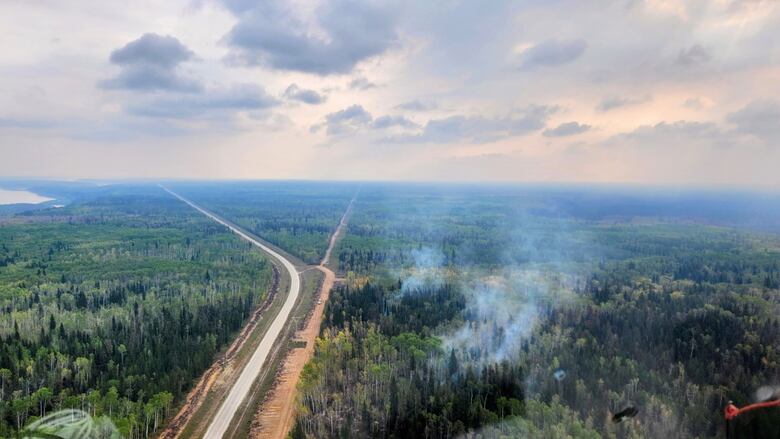Wildfire could close N.W.T.'s Highway 5 on Tuesday with little notice, officials warn
Weather conditions continue to challenge crews fighting wildfires near Hay River and Fort Smith

Highway 5 in the N.W.T. could close on Tuesday with little notice if the eastward finger of the wildfire near Hay River reaches the road.
That warning is contained in the latest written update from territorial fire information officer Mike Westwick, released midday on Tuesday.
"The portion of the most eastward finger of fire, which burned to the shores of Great Slave Lake, grew further overnight – reaching the Birch Creek area and getting very close to Highway 5," he wrote.
"There is a possibility [that the] fire reaches Highway 5 under wind and burning conditions today."
Heavy smoke may also be present in the Highway 5 area if ignition operations go ahead, Westwick warned.

Crews battling the wildfires near Hay River and Fort Smith, N.W.T., expect more challenging weather conditions Tuesday, according to the update.
Temperatures are forecasted to reach 25 C with relatively humidity at just 25 per cent, creating what's called "crossover" – a situation in which temperatures are at or higher than the humidity level, Westwick explained.
"This supports very strong burning conditions and, along with winds coming from the west at 10 to 15 kilometres per hour gusting up to 25 kilometres per hour, could support severe fire activity and growth to the east," he wrote.
Defences on the west side of the river through the Hay River corridor continued to hold on Tuesday, as did work done on the first finger of fire on Highway 5 closer to the Hay River and Riverwoods Estates.
Crews now intend to carry out ignition operations east of the Hay River near the Sandy Creek area if conditions allow, Westwick said.
Their goal is to meet the second, easternmost, finger of fire on the Kátł'odeeche First Nation reserve to prevent any potential westward growth – a move that would help to secure both the reserve and the Town of Hay River.
They are preparing for the ignition by digging away fuel on the other side of a natural break in forest fuel to prevent any fire from escaping the controlled burn, Westwick said.
Airtankers will be in the air fighting the fire to the east of the Hay River and supporting any needs from ignition operations, he added.
Meanwhile, helicopters will continue to hit targets in the Hay River corridor and along Highway 5 to tamp down hotspots and keep the area secure.

Crews are also running sprinklers on the outskirts of the Kátł'odeeche First Nation Reserve and at Birch Creek today.
Firefighters using heavy machinery have now completed 95 per cent of the work of digging away mid- and deep forest fuels from the 35-kilometre stretch of fire edge from Great Slave Lake through the Hay River corridor to the Highway 1 Junction west of town, Westwick reported.
They have also completed nearly four kilometres of the same kind of "tightlining" on the second, eastern, finger of the fire. However, work had to be halted on Monday when fire activity grew too intense.
Direct attack crews are following the heavy machinery in all areas to extinguish anything hot or burning within the edge of the wildfire and to build a strong, secure perimeter around populated areas.
Crews battling the wildfire in the Fort Smith area, meanwhile, completed ignition operations near Foxholes Road on Monday, which will help protect Thebacha, Westwick told CBC's The Trailbreaker Tuesday morning.
They are continuing to look at ignition opportunities in the area, he said.
The perimeter line south of Fort Smith is now considered to be controlled, Westwick added, calling the development "really good news."
"It's great news to hear a return date for Fort Smith there," he said. "There's still a lot of work to be done to protect other communities in the area, and we're going to be putting in the work every single day."
Asked by Trailbreaker host Hilary Bird about highway conditions for people still returning to Yellowknife, Westwick said that there has been active fire along the highway but the team has kept it back.
Crews completed ignition operations on Monday to burn a pocket of fuel that could've given the fire a better path to the highway and disrupt travel, he said.
That operation was successful.
Westwick urged people making their way home to slow down, be careful, and watch for signage and vehicles.
"Please be aware that you're not always necessarily going to see firefighters," he said. "That doesn't mean they're not there. They're in and out of the bush a lot, and you're vehicle can be a really significant hazard to them."